
The Uffizi Gallery is a prominent art museum located adjacent to the Piazza della Signoria in the Historic Centre of Florence in the region of Tuscany, Italy. One of the most important Italian museums and the most visited, it is also one of the largest and best-known in the world and holds a collection of priceless works, particularly from the period of the Italian Renaissance.
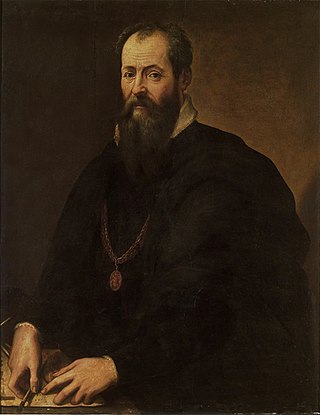
Giorgio Vasari was an Italian Renaissance painter and architect, who is best known for his work The Lives of the Most Excellent Painters, Sculptors, and Architects, considered the ideological foundation of all art-historical writing, and still much cited in modern biographies of the many Italian Renaissance artists he covers, including Leonardo da Vinci and Michelangelo, although he is now regarded as including many factual errors, especially when covering artists from before he was born.

Piero della Francesca was an Italian painter of the Early Renaissance. To contemporaries he was also known as a mathematician and geometer. Nowadays Piero della Francesca is chiefly appreciated for his art. His painting is characterized by its serene humanism, its use of geometric forms and perspective. His most famous work is the cycle of frescoes The History of the True Cross in the church of San Francesco in the Tuscan town of Arezzo.

Federico Barocci (c. 1535 – 30 September 1612) was an Italian Renaissance painter and printmaker. His original name was Federico Fiori, and he was nicknamed Il Baroccio. His work was highly esteemed and influential, and foreshadows the Baroque of Rubens. He is generally considered the greatest and the most individual painter of his time in central Italy.
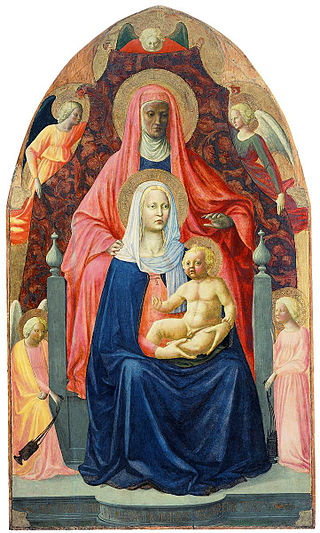
The Madonna and Child with St. Anne, also known as Sant'Anna Metterza, is a painting of c. 1424-1425 by the Italian Renaissance painter Masaccio, probably in collaboration with Masolino da Panicale. The painting is in the Galleria degli Uffizi in Florence, Italy, and measures 175 centimetres high and 103 centimetres wide.
Events from the year 1579 in art.
Central Italian flagellant confraternities evolved and emerged from Central Italian confraternities that originated in the tenth century. The members of these original confraternities were lay persons who were devoted to religious life.

Andrea del Sarto was an Italian painter from Florence, whose career flourished during the High Renaissance and early Mannerism. He was known as an outstanding fresco decorator, painter of altar-pieces, portraitist, draughtsman, and colorist. Although highly regarded during his lifetime as an artist senza errori, his renown was eclipsed after his death by that of his contemporaries Leonardo da Vinci, Michelangelo, and Raphael.
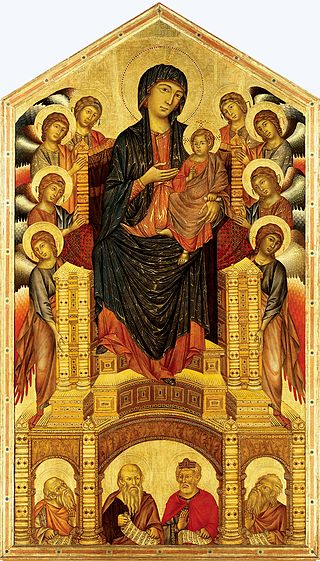
The Santa Trinita Maestà is a panel painting by the Italian medieval artist Cimabue, dating to c. 1288-1292. Originally painted for the church of Santa Trinita, Florence, where it remained until 1471, it is now housed in the Uffizi Gallery of Florence, Italy. It represents the Madonna enthroned with the Baby Jesus and surrounded by eight angels and, below, four half portraits of prophets.

The New Exit for the Uffizi Gallery, designed by architects Arata Isozaki and Andrea Maffei, was the project that won the closed international design competition launched in 1998 with the purpose of expanding the museum's exhibition space and creating a grand exit. Many world-renowned architects participated, among whom were: Mario Botta, Norman Foster, Gae Aulenti, Hans Hollein and Vittorio Gregotti. As part of the Grandi Uffizi initiative, a 60 million euro renovation and development project for the overall museum, the loggia's construction became a controversial subject for Florentines and thus has been at a standstill since its original scheduled completion date of 2003. The project was envisioned as a large steel and stone loggia that would echo its counterpart, the Loggia dei Lanzi on Piazza della Signoria. While at the same time, it would comment on the precarious balance that exists between tradition and modernity in a context that seldom sees large architectural change.
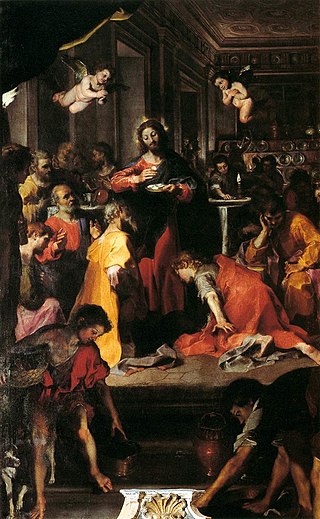
The Communion of the Apostles, or Institution of the Eucharist is a painting of the Last Supper by Federico Barocci located at Santa Maria sopra Minerva in Rome. It was commissioned for the family chapel of Pope Clement VIII Aldobrandini and completed between 1603 and 1608.
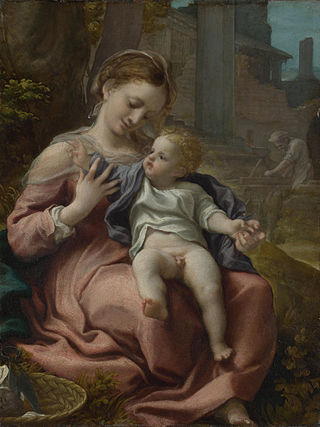
The Madonna of the Basket or the Madonna della Cesta is a painting of c. 1524 by Antonio da Correggio in the National Gallery, London. While it is a Mannerist painting of the Virgin Mary and the Baby Jesus, Correggio included naturalist touches in his composition, like the sewing basket that gives the painting its name.

Madonna della Scodella is an oil painting on panel by Antonio da Correggio, dated from 1528 to about 1530 and preserved at the Galleria nazionale di Parma.
The Diocesan museum of sacred art in Arezzo was founded in 1963 but opened regularly to the public only in 1985, and was housed in several rooms above the sacristy of the Cathedral of San Donato. In 2011 it was relocated to the first floor of the bishop's residence. The museum exhibits works of art and liturgical items, from the 12th to the 19th centuries, that come from the cathedral and other churches in the diocesan territory, significant for their religious and cultural significance to Arezzo and the surrounding area. Highlights of the museum include several works of Giorgio Vasari and the Pace di Siena.

Portrait of a Boy is a 1495 oil on panel portrait, now in the Uffizi in Florence. In the past it has been attributed to Lorenzo di Credi, Viti, Jacopo Francia, Raphael and others, but Giovanni Morelli's reattribution of it to Perugino is now widely accepted. Although the lack of a landscape background is unusual for this painter, the style is typical of his portrait technique.

Portrait of a Woman is a c.1475 tempera and oil on panel painting by Antonio or Piero del Pollaiuolo. It has been in the Uffizi in Florence since 1861. Since 1861 it has been misattributed to Piero della Francesca, a young Leonardo da Vinci and Cosimo Rosselli.

Hercules and the Hydra is a c. 1475 tempera grassa-on-panel painting by Antonio del Pollaiuolo, forming a pair with the same artist's Hercules slaying Antaeus. Both works are now in the Galleria degli Uffizi in Florence. It measures 17 cm by 12 cm, small like all his surviving mythological paintings. It is assumed that both these are miniature copies by the artist of two out of the three enormous paintings on canvas of the Labours of Hercules commissioned from Antonio and Piero del Pollaiuolo by Piero di Cosimo de' Medici for the Sala Grande of the Palazzo Medici in the 1460s, which have now been lost.
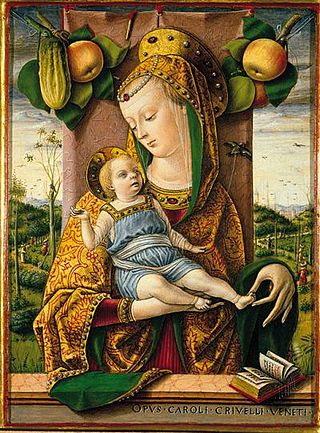
Madonna and Child is a tempera and gold on panel painting by Carlo Crivelli, executed c. 1480, and signed OPVS CAROLI CRIVELLI VENETI. It is now in the Pinacoteca civica Francesco Podesti in Ancona. Its dating has varied on stylistic grounds between the 1470s and 1480s, close in date to the artist's Lenti Madonna and Madonna and Child with an Apple.
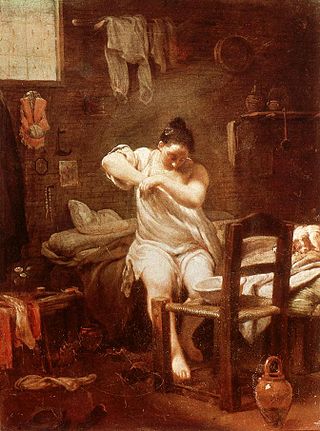
Woman Searching for Fleas, The Flea or Woman Getting out of Bed is a 1710-1730 oil on copper painting by Giuseppe Maria Crespi, a painter from Bologna. The main version is now in the collection of the Uffizi in Florence, whilst variants survive, including one at the Museo nazionale di palazzo Reale in Pisa, also originating in the Guardaroba of the Grand Dukes of Tuscany.

The Nativity is an oil on canvas painting by Italian painter Federico Barocci, created in 1597. It depicts the episode of the Nativity of Jesus. It is held in the Museo del Prado, in Madrid.

















